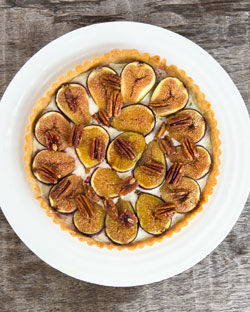Recipe: fig, goat’s cheese, pecan, honey and cornmeal tart


Roula Khalaf, Editor of the FT, selects her favourite stories in this weekly newsletter.
My Latin master, Hawkeye, was an old desert hand. Although not given to sybaritic indulgence, he spoke of the fruits he had seen on his travels with extraordinary relish. It must be realised that most of the class he was addressing (and for which he was forsaking Caesar in this moment of rheumy remembrance) had never seen a fresh date or a fig. We had seen a pomegranate once because one boy’s father was stationed in Jerusalem and had sent one over, at great expense, by air freight. Our idea of exotic fruit was a banana, a pineapple perhaps, or a grapefruit.
Hawkeye spoke movingly of coming across figs in an oasis in, I think, Jordan or Palestine. His memory of that first taste of a truly ripe fruit, its juice spilling down his chin and its intense sweetness was something truly ambrosial. To us, of course, figs were an enjoyable dried fruit and best known in the form of syrup of figs, which matron used to administer if we confessed that we had not “sat down” that day.
Curiously, I had seen figs before the classicist brought them to our attention. We had lived in Northern Ireland in the 1950s and had a spectacular fig tree in the garden. It was spectacular for its foliage – it could have protected the modesty of a thousand Eves – but I was unaware that it was a fruit tree until the magnificent summer of 1957 when it bore three fine figs, something of an anomaly in the unexotic climate of the province. My father instructed my mother to stew them with sugar and water, and then sat down to eat them with a little cream.
If a fig is very ripe, of course, it does not necessarily need cooking. I do not know if I prefer melon or fig with my Parma ham but both are extremely complementary and the fig must definitely be raw. A fig is good with cheese and probably best on its own and cold from the fridge for breakfast. That said, cooking does help it along. Lightly poached with sugar and red wine, with a dash of port added at the end, figs make a good pudding. In the Middle East they are often stuffed with nuts and baked with a little honey. In France they are occasionally stuffed with goat’s cheese. Today’s recipe dangerously borrows from both traditions but I think I have got away with it. At least there is enough to go round.
Rowley Leigh is the chef at Le Café Anglais
——————————————-
Fig, goat’s cheese, pecan, honey and cornmeal tart
Ingredients
The cornmeal pastry is simple to make and gives a sandy, brittle quality to the crumb. Serves 6-8.

150g plain flour
75g cornmeal or polenta
15g light brown caster sugar
½ tsp salt
110g butter
75g goat’s cheese
150ml double cream
1kg figs

50g pecans (or walnuts)
2 tbs acacia or similar fragrant runny honey
● Mix together the flour, cornmeal, sugar and salt. Cut the cold butter into small cubes and rub it into the flour mixture, either with fingertips, in a mixer or a food processor. Once a sandy texture is achieved, with a few very small lumps of butter, add four tablespoons of very cold water and collect into a dough. Wrap in film and rest in the fridge for 30 minutes.

● Preheat the oven to 180C. Place the dough inside a 23cm-24cm tart ring and press down, spreading the dough out with the fist and then the fingers, pushing it up the sides and working it to an even thickness all over. Trim the border with a sharp knife. Line the interior of the tart with a round of greaseproof paper and fill with baking beans. Bake for 20 minutes, remove the beans and paper and cook for a further 10 minutes so that the case is fully cooked and the base is crisp. Leave to cool.
● Cut the goat’s cheese into small cubes and blend with the cream to make a smooth paste. Spoon into the tart case and spread evenly with a spatula. Cut the figs in half and arrange them in a circle on top of the cheese mixture. Sprinkle the pecans over the figs and bake in the oven for a further 15 minutes. Spoon the honey over the figs and glaze, either back in the oven or under a hot grill.
——————————————-
Rowley’s drinking choice
Not an easy call, with the competing claims of fruit, cheese and honey. The default position must be one of those powerful sweet reds from southwest France such as Maury or Banyuls.
Comments